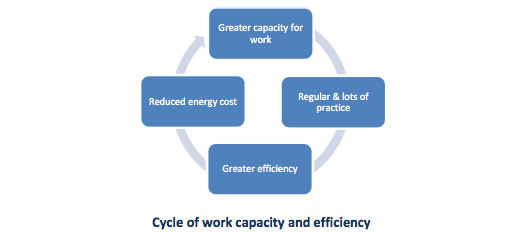THE SP METHOD
The principles in this document provide the rationale for why we coach the way we do at Sport Performance. We don't discriminate on the use of these principles for children versus adults or athletes versus non-athletes. The basis of function and well-being is the same for all bodies.
FIRST PRINCIPAL:
Injury-free and strong: Efficiency and resilience
Strength is the most important commodity in sport (in life if you place importance on moving). Weak muscles impair the efficiency of the body and reduce its resilience to injury.
The body is arranged into an underlying layer of muscles that hold the skeleton together at the joints (stabilisers) and larger muscles to move us around. The power that the body produces – measured by how fast we move or how far we can throw an object – depends on the stability of the movement pattern, i.e. the strength of the stabilisers as well as that of the large mover muscles. An unstable pattern is inefficient because it reduces the amount of 'mover' energy captured for its intended purpose. To become a more powerful athlete the patterns have to become more efficient and that is achieved by making the body stronger.
There is another, even more significant, consequence of weak muscles and inefficient movement patterns: injury. Injuries are commonplace because our bodies are not perfectly designed or adapted and nor are they perfectly employed. The greatest job a conditioning coach can do for an athlete is to identify improvements in the efficiency of the body that will increase an athlete's resilience and time in sport.
SECOND PRINCIPAL:
Physical literacy: Great skills
Coaching abounds in facts and principles and one of the most important involves limitations: An athlete's progress or level of development is a measure of the impact of their limitations. Sporting movements, even apparently simple ones, are highly complex mechanical patterns relying on several motor abilities. Like movements, physical development also involves lots of interacting parts and the capacity of the whole to advance depends on the extent to which the constituent parts evolve.
1. Sporting actions are highly complex and depend on many factors.
2. Physical evolution (adaptation or development) involves interdependent processes.
 The lesson is that if one part of a physical process is weak then the whole process is weak: A chain is only as strong as its weakest link. Build a broad and highly evolved skill set.
The lesson is that if one part of a physical process is weak then the whole process is weak: A chain is only as strong as its weakest link. Build a broad and highly evolved skill set.
THIRD PRINCIPAL:
A great work ethic and a big engine: Constancy, Consistency, & Capacity (the three C's)
In addition to building skills and a strong body, an athlete must evolve a large capacity for work. Work capacity can be defined according to specific tasks but it has another meaning that is of special importance for young developing athletes. Work capacity is a measure of everything that is done regularly and over a period of weeks to months to years. Eventually, as in the example of extreme sports and vocations, the capacity for work evolves to be so large and long standing that months of inactivity only fractionally diminishes certain capacities. In this way we can relate work capacity with skill. A pattern of activity (i.e. movements) may become so well learned that it has a very low energy cost – it becomes incredibly efficient.
This type of efficiency is highly significant for athletes. It can mean performing tasks with greater speed or power, or it can be expressed as the capacity to perform at a high level for longer. The ultimate point, however, is that work capacity takes on a kind of virtuous cycle:
 The work capacity ↔ efficiency cycle can begin from a very young age as it is not a function of chronological age but training or biological age. The earlier it starts the further the development process can be extended. That is how champions and specialists are created and it is the basic meaning of the concept of '10 000 hours'.
The work capacity ↔ efficiency cycle can begin from a very young age as it is not a function of chronological age but training or biological age. The earlier it starts the further the development process can be extended. That is how champions and specialists are created and it is the basic meaning of the concept of '10 000 hours'.
The first step in a long-term athlete development process is constant (everyday) and consistent (repeated excellence) practice. Buy-in occurs when we are keenly interested or attracted to something but it also happens where we have a lot at stake; when the consequence of not doing something exceeds the momentary preference to want to sit on the coach and watch TV. The more I have invested the more I have to lose.
Programming this kind of response is beautifully simple: always attend practice/training, and put a big weekly program of physical activity in place.

![]()